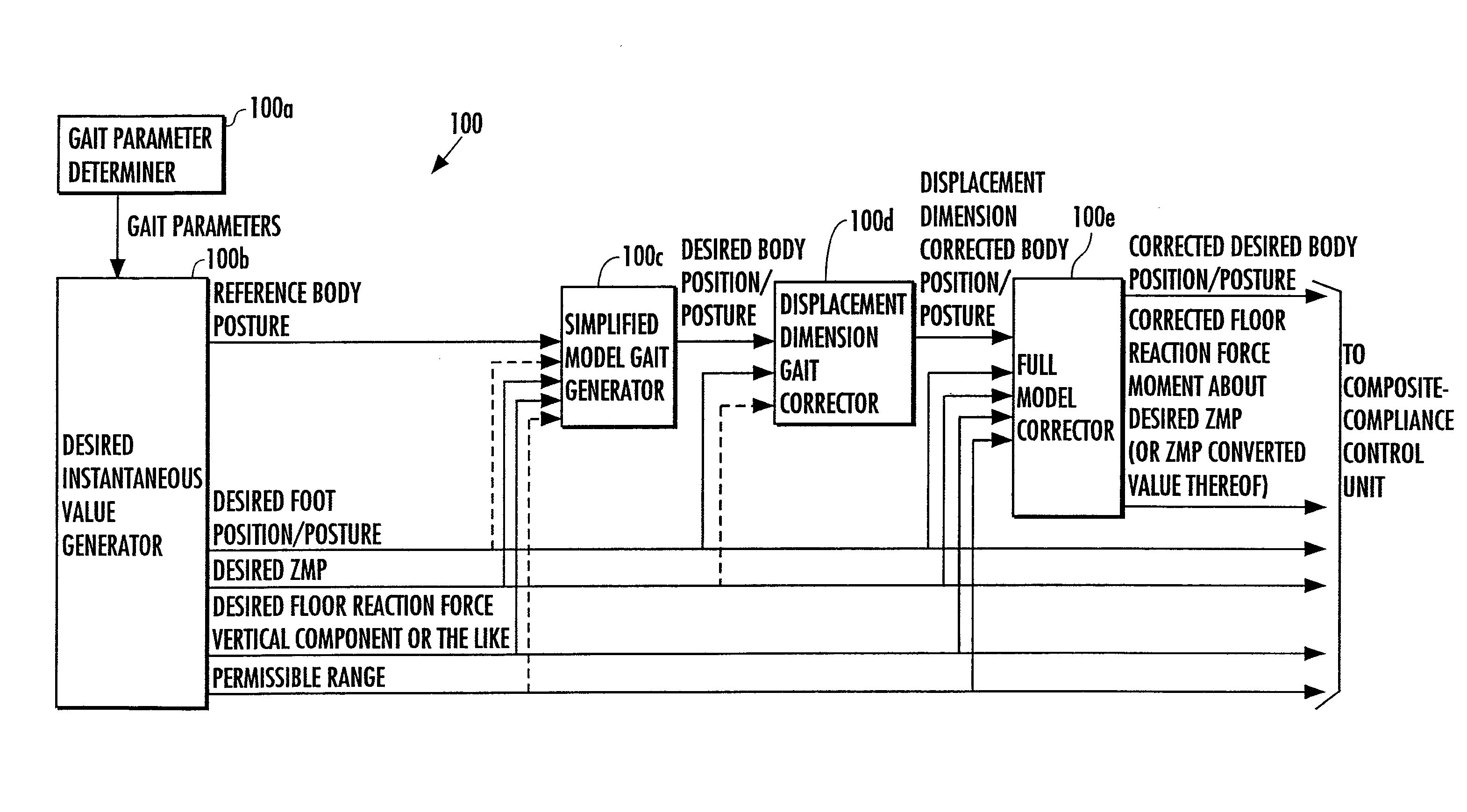Gait generator for mobile robot
a technology for mobile robots and generators, applied in the direction of electric programme control, program control, instruments, etc., can solve the problems of unstable motion of the actual robot, and low dynamic accuracy of the dynamic model of the robot on the dynamic model. to achieve the effect of improving the dynamic accuracy
- Summary
- Abstract
- Description
- Claims
- Application Information
AI Technical Summary
Benefits of technology
Problems solved by technology
Method used
Image
Examples
first embodiment
[0104]A first embodiment in accordance with the present invention will now be specifically explained. First, the simplified model (dynamic model), the first displacement dimension correcting model, and the second displacement dimension correcting model in the first embodiment will be explained. Incidentally, the first embodiment is an embodiment according to the first to the ninth inventions and the eleventh to the fourteenth and the sixteenth inventions described above.
[0105]FIG. 6 shows the structure of a simplified model in the first embodiment. As illustrated, the simplified model is a one-mass-point model equipped with one mass point (body mass point) 3m corresponding to a body 3 of a robot 1. The robot 1 shown in FIG. 6 is the robot 1 schematically side-viewed, omitting arms 5, 5 and a head 6. In the figures following FIG. 6 (including the drawings of embodiments other than the first embodiment), when illustrating the robot 1, the arms 5, 5 and the head 6 will be omitted, as w...
second embodiment
[0200]A second embodiment in accordance with the present invention will now be explained. In the present embodiment, the mechanical construction of a robot 1 and the functional construction of a control unit 60 (the functional construction shown in FIG. 4) are the same as those in the first embodiment. The present embodiment differs from the first embodiment in a simplified model and a first displacement dimension correcting model and partly in the processing of a gait generator 100. Hence, in the explanation of the present embodiment, the same reference numerals and drawings as those in the first embodiment will be used for the same parts as those in the first embodiment and detailed explanation thereof will be omitted. The second embodiment represents an embodiment of the first to the tenth inventions, and the thirteenth to the sixteenth inventions of the present invention.
[0201]FIG. 16 shows a structure of a simplified model (dynamic model) in the present embodiment, and FIG. 17 ...
third embodiment
[0237]A third embodiment of the present invention will now be explained. The present embodiment shares the same mechanical construction of the robot 1 as that of the first embodiment, and differs from the first and the second embodiments in the simplified model, the structures of the first displacement dimension correcting model and the second displacement dimension correcting model, and a part of the processing of the gait generating device 100. Hence, in the explanation of the present embodiment, the same reference numerals and drawings as those of the first or the second embodiment will be used for the same portions as those of the first or the second embodiment, and detailed explanation will be omitted. The following will explain the present embodiment, focusing mainly on the portions that are different from the first or the second embodiment. Incidentally, the present embodiment is an embodiment of the aforesaid first to eighth inventions.
[0238]In the present embodiment, a simp...
PUM
 Login to View More
Login to View More Abstract
Description
Claims
Application Information
 Login to View More
Login to View More - R&D
- Intellectual Property
- Life Sciences
- Materials
- Tech Scout
- Unparalleled Data Quality
- Higher Quality Content
- 60% Fewer Hallucinations
Browse by: Latest US Patents, China's latest patents, Technical Efficacy Thesaurus, Application Domain, Technology Topic, Popular Technical Reports.
© 2025 PatSnap. All rights reserved.Legal|Privacy policy|Modern Slavery Act Transparency Statement|Sitemap|About US| Contact US: help@patsnap.com



